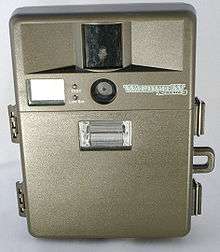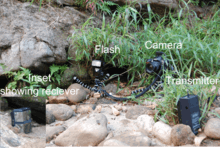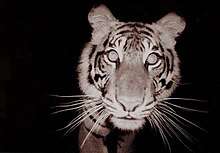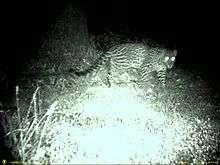Camera trap
A camera trap is a remotely activated camera that is equipped with a motion sensor or an infrared sensor, or uses a light beam as a trigger. Camera trapping is a method for capturing wild animals on film when researchers are not present, and has been used in ecological research for decades. In addition to applications in hunting and wildlife viewing, research applications include studies of nest ecology, detection of rare species, estimation of population size and species richness, as well as research on habitat use and occupation of human-built structures.[1]






Camera traps, also known as trail cameras, are used to capture images of wildlife with as little human interference as possible.[2] Since the introduction of commercial infrared-triggered cameras in the early 1990s their use has increased.[3] With advancements in the quality of camera equipment this method of field observation has become more popular among researchers.[4] Hunting has played an important role in development of camera traps, since hunters like to use them to scout for game.[5] These hunters have opened a commercial market for the devices which have led to many improvements over time.
Application
The great advantage of camera traps is that they can record very accurate data without disturbing the photographed animal. These data are superior to human observations because they can be reviewed by other researchers.[1] They minimally disturb wildlife and can replace the use of more invasive survey and monitoring techniques such as live trap and release. They operate continually and silently, provide proof of species present in an area, can reveal what prints and scats belong to which species, provide evidence for management and policy decisions, and are a cost-effective monitoring tool. Infrared flash cameras have low disturbance and visibility.[6] Besides olfactory and acoustic cues, camera flash may scare animals so that they avoid or destroy camera traps. The major alternative light source is infrared, which is usually not detectable by mammals or birds.[1]
Camera traps are also helpful in quantifying the number of different species in an area; this is a more effective method than attempting to count by hand every individual organism in a field. It can also be useful in identifying new or rare species that have yet to be well documented. By using camera traps, the well-being and survival rate of animals can be observed over time.[7]
Camera traps are helpful in determining behavioral and activity patterns of animals, such as which time of day they visit mineral licks.[8] Camera traps are also useful to record animal migrations.[9][10]
Camera types
The earliest models used traditional film and a one-shot trigger function. These cameras contained film that needed to be collected and developed like any other standard camera. Today, more advanced cameras utilize digital photography, sending photos directly to a computer. Even though this method is uncommon it is highly useful and could be the future of this research method. Some cameras are even programmed to take multiple pictures after a triggering event.[11]
There are non-triggered cameras that either run continuously or take pictures at specific time intervals. The more common ones are the advanced cameras that are triggered only after sensing movement and/or a heat signature to increase the chances of capturing a useful image. Infrared beams can also be used to trigger the camera. Video is also an emerging option in camera traps, allowing researchers to record running streams of video and to document animal behavior.
The battery life of some of these cameras is another important factor in which cameras are used; large batteries offer a longer running time for the camera but can be cumbersome in set up or when lugging the equipment to the field site .[7]
Extra features
Weather proof and waterproof housing for camera traps protect the equipment from damage and disguise the equipment from animals.[12]
Noise-reduction housing limits the possibility of disturbing and scaring away animals. Sound recording is another feature that can be added to the camera to record animal calls and times when specific animals are the most vocal.[2]
Effects of weather and the environment
Humidity has a highly negative effect on camera traps and can result in camera malfunction. This can be problematic since the malfunction is often not immediately discovered, so a large portion of research time can be lost.[6] Often a researcher expecting the experiment to be complete will trek back to the site, only to discover far less data than expected – or even none at all.[11]
The best type of weather for it to work in is any place with low humidity and stable moderate temperatures. There is also the possibility, if it is a motion activated camera, that any movement within the sensitivity range of the camera’s sensor will trigger a picture, so the camera might end up with numerous pictures of anything the wind moves, such as plants.
As far as problems with camera traps, it cannot be overlooked that sometimes the subjects themselves negatively affect the research. One of the most common things is that animals unknowingly topple a camera or splatter it with mud or water ruining the film or lens. One other method of animal tampering involves the animals themselves taking the cameras for their own uses. There are examples of some animals actually taking the cameras and snapping pictures of themselves.[11]
Local people sometimes use the same game trails as wildlife, and hence are also photographed by camera traps placed along these trails. This can make camera traps a useful tool for anti-poaching or other law enforcement effort.
Placement techniques
One of the most important things to consider when setting up camera traps is choosing the location in order to get the best results. Camera traps near mineral licks or along game trails, where it is more likely that animals will visit frequently, are normally seen. Animals congregate around mineral licks to consume water and soil, which can be useful in reducing toxin levels or supplement mineral intake in their diet. These locations for camera traps also allow for variety of animals who show up at different times and use the licks in different ways allowing for the study of animal behavior.[7]
To study more specific behaviors of a particular species, it is helpful to identify the target species' runs, dens, beds, latrines, food caches, favored hunting and foraging grounds, etc. Knowledge of the target species' general habits, seasonal variations in behavior and habitat use, as well as its tracks, scat, feeding sign, and other spoor are extremely helpful in locating and identifying these sites, and this strategy has been described in great detail for many species.[13]
Another major factor in whether this is the best technique to use in the specific research is which type of species one is attempting to observe with the camera. Species such as small-bodied birds and insects may be too small to trigger the camera. Reptiles and amphibians will not be able to trip the infrared or heat differential-based sensors, however, methods have been developed to detect these species by utilizing a reflector based sensor system. However, for most medium and large-bodied terrestrial species camera traps have proven to be a successful tool for study.[11]
See also
References
- Swann, D. E., Kawanishi, K., Palmer, J. (2010). "Evaluating Types and Features of Camera Traps in Ecological Studies: A Guide for Researchers". In O'Connell, A. F.; Nichols, J. D., Karanth, U. K. (eds.). Camera Traps in Animal Ecology: Methods and Analyses. Tokyo, Dordrecht, London, Heidelberg, New York: Springer. pp. 27–43. ISBN 4-431-99494-7.CS1 maint: multiple names: authors list (link)
- "WWF - Camera Traps - More on Camera Traps". World Wildlife Fund - Wildlife Conservation, Endangered Species Conservation. World Wildlife Fund. Retrieved 4 October 2011.
- Meek, P.; Fleming, P., eds. (2014). Camera Trapping. CSIRO Publishing. ISBN 9781486300396.
- "Camera Traps for Researchers, Camera Trap Reviews and Tests". Trail Cameras, Game Cameras Tests and Unbiased Reviews of Camera Traps. Retrieved 4 October 2011.
- Jiao, H. (2014). "Wireless Trail Cameras". Trail Camera Lab. Retrieved 11 April 2017.
- Cronin, S. (2010). "Camera trap talk" (PDF). Photographic Society, April 2010. Archived from the original (PDF) on 2012-03-03. Cite journal requires
|journal=(help) - "A-Z Animal Index". Smithsonian Wild. Smithsonian. Retrieved 29 November 2011.
- Blake, J. G.; Guerra, J.; Mosquera, D.; Torres, R.; Loiselle, B. A.; Romo, D. (2010). "Use of Mineral Licks by White-Bellied Spider Monkeys (Ateles belzebuth) and Red Howler Monkeys (Alouatta seniculus) in Eastern Ecuador" (PDF). Internal Journal of Primatology (31): 471–483.
- "How a Photographer Captured Stunning Wildlife Photos". video.nationalgeographic.com. Retrieved 2015-07-22.
- Hance, J. (2011). "Camera Traps Emerge as Key Tool in Wildlife Research". Yale Environment 360. New Haven: Yale University.
- O'Connell, A. F., Nichols, J. D., Karanth, U. K. (Eds.) (2010). Camera Traps in Ecology: Methods and Analyses. Tokyo, Dordrecht, London, Heidelberg, New York: Springer.CS1 maint: multiple names: authors list (link) CS1 maint: extra text: authors list (link)
- Griffiths, M.; van Schaik, C. P. (1993). "Camera-trapping: a new tool for the study of elusive rain forest animals". Tropical Biodiversity. 1: 131–135.
- Pesaturo, Janet (2018). Camera Trapping Guide: Tracks, Sign, and Behavior of Eastern Wildlife. Guilford: Stackpole Books. pp. 1–264. ISBN 978-0811719063.
Further reading
- Rovero, Francesco; Zimmermann, Fridolin (2016). Camera Trapping for Wildlife Research. Exeter: Pelagic Publishing. ISBN 978-1-78427-048-3.
- Pesaturo, Janet (2018). Camera Trapping Guide: Tracks, Sign, and Behavior of Eastern Wildlife. Guilford: Stackpole Books. ISBN 978-0811719063.
- Kays, Roland (2016). Candid Creatures: How Camera Traps Reveal the Mysteries of Nature. Baltimore: Johns Hopkins University Press. ISBN 978-1421418889.
External links
| Wikimedia Commons has media related to Camera traps. |
